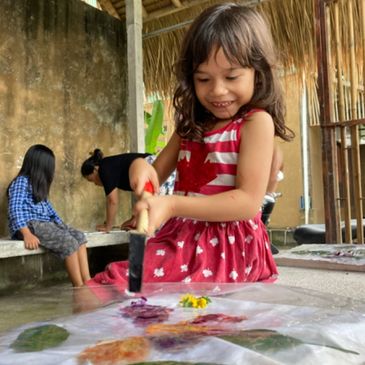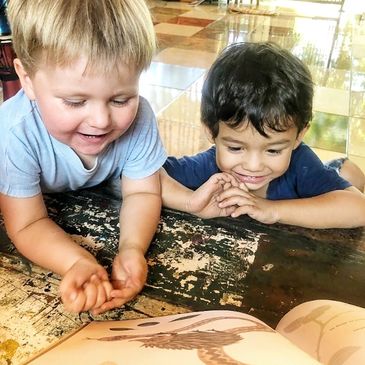Nursery & Reception (Early Childhood)

Arts and Crafts
Arts and Crafts
Arts and Crafts
Kindergarten children are all naturally drawn to the arts. While they are young is the perfect time to introduce them creatively to colors. Children are naturally drawn to beauty and love to create beauty. It is most important to always display what they have created for them to enjoy and appreciate as much as possible. Recycling material
Kindergarten children are all naturally drawn to the arts. While they are young is the perfect time to introduce them creatively to colors. Children are naturally drawn to beauty and love to create beauty. It is most important to always display what they have created for them to enjoy and appreciate as much as possible. Recycling materials for art projects is a way to enhance their inborn sense of innovation. Painting and finger painting are always inspiring ways for children express themselves. Even our early childhood students spend time each day in our Art Class, fully immersed in creation and beauty.

Language Arts
Arts and Crafts
Arts and Crafts
Our Early Childhood Language Arts Program is based on three elements of foundational learning, Conceptualization, Verbalization and Literacy. We break this down beyond the natural integration within the entire day and all other subjects, into two specific programs, Phonics and Neohumanist based Language Arts. This is a way of teaching Lan
Our Early Childhood Language Arts Program is based on three elements of foundational learning, Conceptualization, Verbalization and Literacy. We break this down beyond the natural integration within the entire day and all other subjects, into two specific programs, Phonics and Neohumanist based Language Arts. This is a way of teaching Language Arts as a communications program, where the children are given a maximum opportunity to express themselves in all ways. This is done for example through discussions, storytelling (both listening to and participating in, i.e retelling and creating), artistic storytelling (story pictures and prop based stories), body language activities (pantomime). Rhyming games and exercises and riddles support pronunciation while dramas enhance communication and social interaction skills as well as promote concentration. While the children are youngest, they focus on the alphabet through stories, art and nature based letter and sound recognition games and projects.

Rationality
Arts and Crafts
Rationality
In Nursery and Reception the children are first becoming familiar with numbers as symbols and learning to understand the meaning of this. They are practicing counting and working up to basic addition concepts through hands on projects, usually artistic in nature, and always involving materials and visuals. They will work their way through
In Nursery and Reception the children are first becoming familiar with numbers as symbols and learning to understand the meaning of this. They are practicing counting and working up to basic addition concepts through hands on projects, usually artistic in nature, and always involving materials and visuals. They will work their way through Year 1 mastering addition and subtraction up to two digits as well as beginning to explore width and depth and length as concepts. Throughout the years they will implement matching and comparing activities, practice and master rational and rote counting, They will use materials to fully conceptualize quantity as a concept.
Children are naturally curious and drawn to the elements found within nature (earth, air, fire and water). Science and gardening are ways children can start to explore and interact personally with these, experientially. Through building pinwheels for example they can experience the wind, through planting seedlings and watching them grow they learn about water, earth and sunshine. There are endless ways for the children to be inspired as they participate in projects that illuminate their ever expanding worlds.

Character Building
Character Building
Character Building
Discipline in the early years is viewed as the channeling of ones energy to best develop the individual, which in turn collectively develops society. Within Neohumanist perspective discipline should always be handled from a positive, loving and encouraging perspective. The teacher must blend with the child, to move with the child’s flow t
Discipline in the early years is viewed as the channeling of ones energy to best develop the individual, which in turn collectively develops society. Within Neohumanist perspective discipline should always be handled from a positive, loving and encouraging perspective. The teacher must blend with the child, to move with the child’s flow to create a positive self image, careful to not instill any sense of inferiority within the child. It is believed that mistakes should be explained and children must be treated with respect at all times. A collective sense of belonging must be cultivated as the children learn their individual role within the group. Positive reinforcement and clear boundaries will help the children develop their growing independence. The teachers are able to set an example as role models while inspiring through songs, story time, guided meditation and visualizations.
Etiquette is important for children to develop as they learn how to interact with the world around them. They learn how kindness, courtesy and grace support harmony whether in a small group or in the world at large. They can learn the beauty of the feeling of making other people around them feel happy. Stories are a perfect chance to show how the way one behaves towards others, causes ripples outward. Roleplaying and games are a fun way for the children to practice many different kinds of situations as they start to master their growing skills and understanding.

Movement
Character Building
Character Building
As we all know children, especially young children, love to move. From a Neohumanistic perspective even these young children can learn how to move carefully and precisely. They can learn the right way to handle all objects by experiencing them and therefore strengthening their dexterity. Squeezing,stringing, cutting, folding, spooning, op
As we all know children, especially young children, love to move. From a Neohumanistic perspective even these young children can learn how to move carefully and precisely. They can learn the right way to handle all objects by experiencing them and therefore strengthening their dexterity. Squeezing,stringing, cutting, folding, spooning, opening and closing and flower arrangement are all excellent ways to strengthen fine motor skills. Moving to rhythms, creative movement, coordination exercises including asanas, balancing exercises all support gross motor development. Of course natural outdoor play, throwing and catching, tumbling and sliding, swinging and running games and sports are ways the children all engage in daily movement development through their own lead.
Yoga Asanas are a very large part of our morning program for all students. It helps them relax as well as improve circulation and restore energy. It enhances their concentration abilities. Yoga can also help the children transition between high energy activities to more quieter times. Spiritual dances are also brought many mornings to morning circle. Dancing is essential to young children’s ability to preserve their innate joy and grace.

Circle of Love
Character Building
Circle of Love
The preschool children spend their school year traveling through the cycle of creation. Starting with the origin, Universal Love or God (children clearly understand Love and are able to comprehend through their feeling, a universal existence beyond what they can see or understand literally), and moving through the elements (space, air, fi
The preschool children spend their school year traveling through the cycle of creation. Starting with the origin, Universal Love or God (children clearly understand Love and are able to comprehend through their feeling, a universal existence beyond what they can see or understand literally), and moving through the elements (space, air, fire and water, earth), to plants, insects, fish and reptiles, birds, mammals, myself and family, to people around us and saints (as we move back up to Universal Love). The units of this program are enriched with dramas and costume plays, stories, songs, guided discussions and meditations/visualizations, and art projects. The aim is to help the children explore, understand and assimilate their understanding of the universe and their own place within it from an inspired and spiritual perspective, feeling the universal connection.
This website uses cookies.
We use cookies to analyze website traffic and optimize your website experience. By accepting our use of cookies, your data will be aggregated with all other user data.
